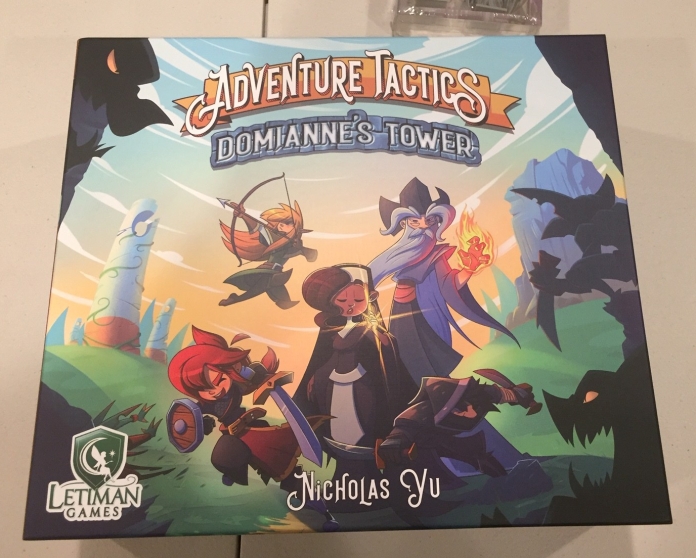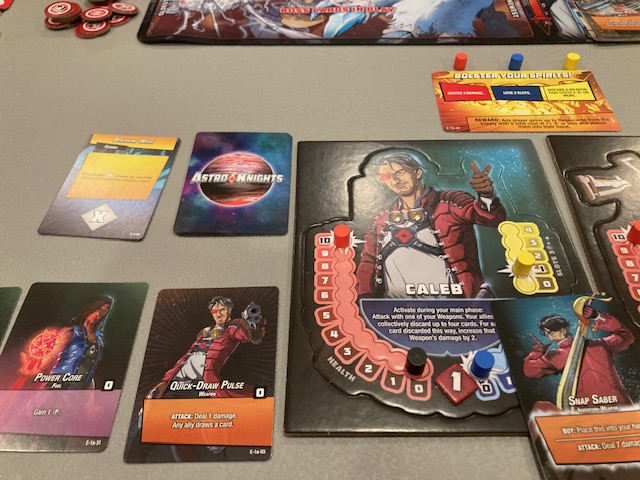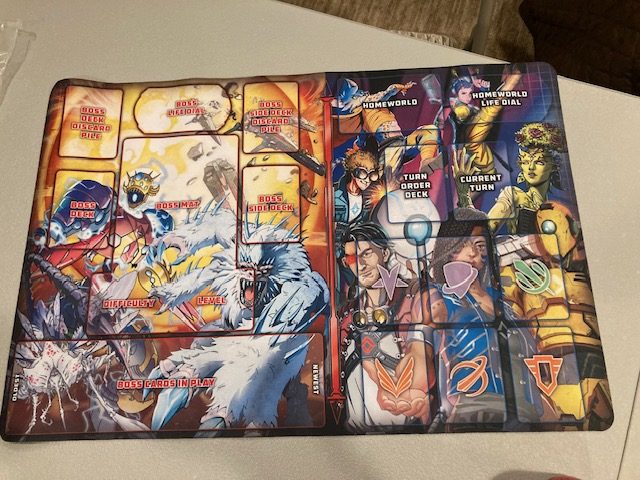Welcome to the end of Variable Turn Order Month! This month we saw Astro Knights: Expeditions with its card-based Variable Turn Order, then we saw The Plum Island Horror and its token and bag-based Variable Turn Order! We conclude this month with a discussion of some of the problems with Variable Turn Order and some ideas for fixing these issues!

Over the past few years, we’ve seen the Variable Turn Order mechanism show its face in quite a number of games! This is a mechanism that directs the order of players and “bad news components” in cooperative games. The first place I really saw Variable Turn Order was in Aeon’s End! Aeon’s End is a cooperative deck-builder and boss-battler game. I Kickstarted the original Aeon’s End and the War Eternal versions back in something like 2017: see our reviews here.

At that time, I was still enamored with the entire cooperative deck-building experience, and I didn’t quite understand the full-reaching effects of the Turn Order Deck (see above), which controls the Variable Turn Order in Aeon’s End and War Eternal.
What Is Fixed Turn Order and Variable Turn Order?

Many many many cooperative games have a simple order of play: the Bad News happens then the players go in (something like) clockwise order. The Bad News happens, then each player gets a turn. This would be a Fixed Player Order game. Some examples of this would be Arkham Horror 2nd Edition (see snippet from rulebook above), Sentinels of the Multiverse, and Marvel Champions: Fixed Player Order (as the name implies) dictates that play unfolds in the same order every turn (modulo the First Player marker moving). We discuss this in greater detail in a few places: Arkham Horror and Sequential play, Marvel Champions and Sentinels of the Multiverse on entry #7.

Variable Turn Order is random system in which the game controls the order of the players and the order of the “Big Bad”. In most cooperative games, players are playing against the game; that’s usually expressed as a major villain (the “Big Bad”) the players are fighting against (See RageBorne from Aeon’s End above: he’s the major villain)! So, when the “Big Bad” takes a turn, it’s the game controlling some way for the game to attack/inhibit the players. When a player plays, he usually attacks the “Big Bad” or helps himself or compatriots in some way.

In Aeon’s End, the Variable Turn Order is expressed through The Turn Order Deck. The Turn Order Deck is a small deck of 6 cards which controls the order in which the players can take a turn or the Big Bad (the Nemesis, controlled by the game) can take a turn. There are 4 player cards and 2 Nemesis cards (see above). You shuffle the deck and draw the next card: that card tells you who goes! So, the players get 4 turns, and the Nemesis gets 2 turns, and then you start again. This is a card-based system.

In The Plum Island Horror (which we just reviewed last week), the Variable Turn Order is expressed through drawing tokens from a bag (see tokens above). The players get 4 turns (2 green and 2 blue tokens) and the game “Big Bad” gets 4 turns (3 red and 1 black tokens). This is token-based system.
Some Cooperative Games With Variable Turn Order
Here’s an (incomplete) list of cooperative games we know of with Variable Turn Order. All of these games here are standalone games, but some of them also expand a base game.
- Aeon’s End: a cooperative deck-builder with card-based Variable Turn Order. See our review of Aeon’s End and War Eternal here.
- Aeon’s End: The Outcasts. As Aeons’ End. See our review of Outcasts here.
- Aeon’s End: The New Age. As Aeon’s End. We discuss The New Age in Outcasts review.
- Adventure Tactics: A cooperative dungeon crawler with token-based Variable Turn Order. See our review of Adventure Tactics here.
- Unmatched Adventures: A cooperative boss-battler with card-based Variable Turn Order. See Our review here.
- Astro Knights: a cooperative deck-builder with card-based Variable Turn Order. See our review of Astro Knights here.
- Astro Knights: Expeditions: same as Astro Knights. We reviewed Astro Knights: Expeditions at the start of Variable Turn Order month!
- Kinfire Chronicles: a cooperative dungeon crawler with elements of deck-building: uses token/bag-based Variable Turn Order. See our review here.
- The Plum Island Horror: A cooperative tower defense game with token/bag-based Variable Turn Order. See our review last week!
A common theme is cooperative deck-builders, but we also see in this list in a tower defense game and some dungeon crawlers!
The Problems
The problems with Variable Turn Order games are two-fold, but related.
- Lack of Mitigation: Most (if not all) Variable Turn Order order games don’t have any mechanisms for mitigating or affecting the Variable Turn Order. It’s much more difficult to make tactical/strategic decisions based on who will or “might” go next.
- Pathologically Bad Turn Order: Variable Turn Order can go pathologically bad and shut-out players for far too many turns. This is usually expressed by the Nemesis taking all of his turns at the end of the round, and then all of his turns at the start of the next round!
As an example of Pathologically Bad Turn Order, consider The Plum Island Horror: if all 4 “Big Bad” tokens are drawn at the end of the phase, and then bad luck brings all 4 “Big Bad” tokens out at the start of the next phase, that shuts the players out of the game for 8 full turns! This will frequently cause an immediate loss, especially in the late game.

I have personally witnessed losses in Aeon’s End many times from The Variable Turn Order giving the Nemesis 3 or 4 turns in row: in the late Aeon’s End game, this is devastating as a Nemesis turns are very powerful. It’s very frustrating to watch 3 or 4 turns go the players can do nothing .. and just lose!

At least Aeon’s End is only a 60-90 minute game: if players get screwed by randomness, it’s okay because it’s a shorter game. I am more worried about being screwed in the game of Plum Island Horror because it’s a significantly longer game: imagine being three hours into a game then watching it be destroyed because the game takes 8 unanswered turns in a row!
External Solutions
So, if the game has no mitigation techniques built-in, you hope not destroying the game balance . We’ll explore an external mechanism: a mechanism outside of the game and rules.

Back in Seven House Rules for Cooperative Games (see link here), under entry #1, we proposed a simple solution for Aeon’s End: The nemesis is never allowed more than 2 turns in a row. In other words, if you ever would draw a third nemesis card, you stick it back in the deck and draw until you get a player card. (For token based schemes, you’d do the same kind of thing, but with tokens). This has the effect of preventing the Pathologically Bad Order by simply never allowing it to happen.

A slight refinement of this idea came up in our Plum Island Horror review (last week’s review):
There are no mechanisms to mitigate Variable Turn Order—that’s the problem with it. Our stock suggestion is to make it so the Horrors can never have more than X turns in a row (where X=2 or X=3 depending on your tolerance) . One easy way to do this: if he players have two turns in a row, they must draw a horror token. If the horrors have two turns in a row, the players must draw a player token. This is more of a balancing mechanism, but simple enough.
This slight adjustment makes the game a little more regular as no entity can ever have “too many” turns in a row. Although it’s almost always the “Big Bad” having Pathologically Bad Turn Order that’s frustrating, if the players have too many turns in a row (especially in the end game), the game becomes too easy!! Let’s be clear: Variable Turn Order strikes two ways: too easy or too hard. This slight adjustment (by disallowing the players AND the “Big Bad” more than a few turns in a row) keeps the game a little more fair.
Let’s be clear: the entire purpose of this external mechanism is to prevent the Pathologically Bad Turn Order. It’s a simple enough technique that you can adjust it to your own preference. For example, I can see allowing Pathologically Bad Turn Order early in a Aeon’s End game (because it’s not devastating), but maybe controlling turn order a little more in the end game where it matters more.
We’ll call this the External Prevention technique.
Internal Mechanisms
A number of newer games do have some mechanisms built-in to the game to effect the turn order.

Adventure Tactics: Adventures in Alchemy is an expansion to the base Adventure Tactics game. This expansion adds some new content but fixes a lot of issues with the game (it also made the #7 on our Top 10 Cooperative Expansions of 2023).

On Page 5 of the Expansion Rulebook lists several ways to deal with Variable Turn Order! That’s right, the expansion addresses this issue directly!
- Fate Counter: The first way is to have a limited resource (The Fate Counter: see column 1 above) which you can discard to swap the order of two initiative tokens. This is a simple mitigation technique, but it gives the users some agency when it really matters
- Static Initiative Invariant: The second way is to simply get rid of Variable Turn Order and use “The Static Initiative Variant” (see column 2). You’ll see this is a much more constrained version of the External Prevention Technique: It simply becomes Fixed Turn Order. For example, for a 4-Player game, the game prescribes Hero, Boss, Hero, Hero, Box, Hero, Hero as the order. It’s interesting to read Note 2: “With a predictable initiative turn order, you might find the game a bit easier”.
This expansion should be giving designers ideas! I like the idea of the Fate Counter: you can stop the randomness of Variable Turn Order … once. If you think the Prevention Technique we discussed earlier is too “ad-hoc”, then maybe you’d prefer a more formal technique like having a token (or two) you can discard to stop the randomness.

Kinfire Chronicles (which we reviewed here) is a bag and token based Variable Turn Order game.

Although Kinfire Chronicles can suffer from the Pathologically Bad Turn Orders, it does have a (limited) mitigation technique called (interestingly similar) Fate Tokens.

The players start the game with 2 Fate Tokens.

Players may then spend a Fate Token before drawing from the bag: if you do so, you get to draw 4 tokens out of the bag and choose which one you want!
So, Kinfire Chronicles gives you a limited resource which you can use to mitigate the Pathologically Bad Turn Order issue! I like how you get to draw 4 tokens and choose which token to keep! This make it even more powerful, as you get more choice in who might go next!
It’s interesting that both Adventures in Alchemy: Adventure Tactics and Kinfire Chronicles call this more formal token a Fate Counter/Token. Perhaps that’s what this should called?
The Fate Token is a mitigation technique in Variable Turn Order games: it’s a limited resource which players must discard to affect the turn order (either by re-arrangement, or redrawing). By limiting its uses, players only use it when it’s absolutely essential to prevent Pathologically Bad Turn Order.
Summary
We’ve seen three ways to deal with the Pathologically Bad Turn Order issues:
- External Prevention: Players, on an ad-hoc basis, limit the draw tokens/cards to prevent “too many” of any one type coming out. This prevents both the players and the “Big Bad” from running away with the game.
- Static Initiative Variant: As coined by Adventure Tactics: Adventures In Alchemy, players have a static chart which basically enforces a strict order, preventing any randomness in the system.
- Fate Tokens: As coined by Adventure Tactics: Adventures in Alchemy, but further perfected in Kinfire Chronicles, players have a limited number of tokens they can use to either re-arrange or re-draw cards/tokens to prevent Pathologically Bad Turn Order.
A Case Study: Using Fate Tokens in UnMatched Adventures in the Solo Game

In our review of UnMatched Adventures: Tales To Amaze, we saw the Variable Turn Order was card-based.

In that review, we found that the Variable Turn Order of the 4-Player game must less intrusive than the Variable Turn Order of the 1-Player game! The issue here was more of statistics: you are far less likely the get a Pathologically Bad Turn Order in a 4-Player game, as there’s more cards (8 cards total = 4 player card, 4 “Big Bad” cards).

Compare this to the 1-Player game, which only has three cards in the Initiative Deck: Hero, Villain, and Minion. The odds of the solo player being shut-out for 4 turns is much more likely (2 bad guys at the end of a turn, 2 bad guys at the start of the next turn) just because there are so few cards!

Our plan: play the solo game with two Fate Tokens. Since there are so few cards in the deck, we’ll simply make it so that discarding the fate token allows you to choose the next card from what remains in the Initiative deck. You might notice that these are the Fate Tokens from Kinsfire Chronicles: this was on purpose.

For our UnMatched Adventures test play, we’ll play Daredevil in a solo game.

You can see all the influencing games above!

Now, after our first game with just 2 Fate Tokens, it was clear that Pathologically Bad Turn Order comes out a lot more than we expected! We were trounced pretty quickly.

In our next game, we borrowed another token from Kinsfire Chronicles as a third Fate Token.

Even during that game, I cheated and added a fourth Fate token. It’s pretty clear that the Pathologically Bad Turn Order can really run you over.


In my final game, I was barely able to pull of a win with 4 Fate Tokens. I am leaning towards: 4 tokens for a solo game, 3 for a 2-Player game, 2 for a 3-Player Games, and 1 for the 4-Player game. That may be too much: you may want to reduce it by 1.
Case Study 2: Using Fate Tokens in a 3-Player UnMatched Adventures Games

For this play-through, we used two Fate Tokens for a 3-Player game. We played with the power of the Fate Tokens: we allowed us to draw any Initiative card we wanted when we use the Fate Token. In our case, we used it both times to keep Cloak from dying in the early game. (We played Daredevil, Cloak and Dagger, and Black Window vs Mothman).

In our case, we still lost, but part of that was misplaying Cloak and Dagger, and realizing the abilities of Cloak and Dagger don’t work quite as well: they can make a foe discard cards … which isn’t as useful in the cooperative version.

It was clear the 2 Fate Tokens were very useful: we used them to save Cloak early in the game! Cloak might have died a lot earlier in the game, and the game would have been much less fun. As it was, we still lost, but it was a “satisfying loss”: we felt that we got close. The randomness that shows up from Variable Turn Order was kept under control.
We did wonder if maybe 3 Fate Tokens might have been better, but we felt like that may be too powerful.
Conclusion

Hopefully, you have a better understanding of Variable Turn Order and ways to mitigate it so its inherent randomness doesn’t destroy your games. There are a lot of cooperative games with Variable Turn Order, so it’s nice to know they are some standard mays to mitigate that randomness:
- External Prevention: This is an ad-hoc mechanism you can use in most Variable Turn Order Games: Don’t let the “Big Bad” have more than X turns in a row (where X=2 or 3 usually). A more balanced approach is to also not let the players have more than X turns in a row. Basically, you balance the game as you go.
- Static Initiative Invariant: Eschew all randomness of the Variable Turn Order and have a static order for the initiative tokens/cards to come out: see how Adventure Tactics: Adventures in Alchemy operates for more info.
- Fate Tokens: For a more formal mechanism, games like Kinsfire Chronicles suggest using a limited number of Fate Tokens to help mitigate the randomness. You can either use it to draw the exact cards/token you want (like we did on our UnMatched Adventures case studies), or draw a bunch of tokens/cards to give you more choices (the latter method only works well in Kinsfire Chronicles because there are so many tokens in the bag).
Don’t feel afraid to add a mitigation mechanism to your cooperative Variable Turn Order games: They are your games! For me and my groups, these mechanisms make the game more fun!
One final story: my friend Joe, Kurt, and I were playing UnMatched Adventures a few weeks ago: Joe was coming over to have Dr. Strange heal my Daredevil, but nope, Variable Turn Order had the exact wrong bad guy come out and murder poor old Daredevil. It was depressing, and made Joe dislike UnMatched Adventures because it appeared too random too him: I think with one of the mitigation techniques above, we might change Joe’s mind!



























































































































